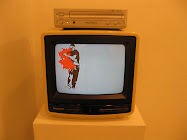
What common denominator links your diverse raw imagery? Between the abstract digital images that make up the stripe paintings, surveillance photographs for the dot paintings and most recently your Moiré random patterning; what brings you to choose your original subjects?
There is always a common denominator to a body of work, seeing it just depends on how far back you are standing. Each of my investigations is initially based on personal experiences as perceived through transformative technologies. One evolves out of the other and the lineage is quite clear to me.
For example, the stripe paintings began as an effort to paint the blurred images I photographed looking out of moving car windows taken while driving cross country. The Traffic Cam paintings pick up that thread as seen through the surveillance work. The surveillance work came about after seeing images of the London bombers all over the news. Having lived in London and traveled the same tube stops, I felt quite shaken by the events and began the series in response. The Moiré paintings are based solely on technical possibilities I observed while making the stripe paintings; the random dot patterns evolved from early experiments applying drips of paint while working with random color generators. They're all connected.
 Skinhead, 2007
Skinhead, 2007
Where does the rigidity of your process come from? Does the fabrication of your artwork dictate your expression?
The rigidity of the process comes from the equipment. It can really be quite dangerous, so you have to be necessarily rigorous or the consequences can be severe. I do like the structure of the process. If anything, I see a circular influence between the fabrication and the expression. This framework allows me to examine and understand things in a defined space.

M-0309, 2007
There seems to be parity between what the image was and what it could be. Does technology focus your ambiguity?
The systems were designed to be a transparent process. That was the goal at least, but I think they inevitably have the effect of eroding specifics- which I kind of like. Over time one learns the degree to which erosion and any potential shifting occurs, and the ability to apply it in a deliberate fashion becomes recycled into the process.
Software controlled linear motion machines are a basic tool of much of your work, how do its computer languages and specific limitations help limit alternatives?
All of my work is fundamentally digital in nature. As long as I continue to work in that manner, I really do not feel any constraints. Programming languages really do not constrain, they provide another layer of alternatives. Beyond the programming itself, the process has its own language there is a great deal of expressive latitude once the grammar is understood. Technology provides me with location, specifically and accurately, and the action I execute in a specific event is really what I am interested in- applying paint or what have you.
Do you feel a curatorial element in your artistic practice? By removing your 'hand' from the art making, is your position in relation to painting open to more choices?
Over a body of work a relationship to one’s choices becomes obvious; they narrow the viewer's position regardless of the artist's intent. I do think there is a curatorial element to my practice but it is only over a very narrow horizon. I view my relationship with the work less as a critique and more as champion pushing from the inside.
How do you view the difference between artist and artisan?
The differences are based on economic intent, not on tools or methods.
Given the theoretical lack of authorship in post modernism, in what ways is your personality and demeanor invested in your paintings?
I develop the conceptual framework, select and refine images, determine variables, select colors, mix paint and oversee the technical process. Inevitably these activities reflect my personality and demeanor simply by the choices of which processes and methods I use to make my work. These are not arbitrary inputs; they are the sum of my investment- the reality of the finished work.
Where are you going next with your practice?
If I knew that I would be doing it already.























2 comments:
Thanks for posting that.
Good question about art/artisan, and interesting answer. Betts's pieces are actually well-constructed objects as such. The stripe paintings are on solid wood (actually MDF or some other form of dimensionally stable engineered lumber) integrated onto a rigid wooden frame, and the spots are on engineered aluminum panels. Don't know off-hand about the moire or camera paintings.
Post a Comment